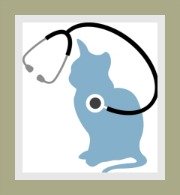Feline AIDS
The Cause and Spread of Cat HIV
Feline Aids or Feline Immunodeficiency Virus (FIV) is caused by a retrovirus which is very similar to the Feline Leukemia Virus (FeLV).
The retrovirus belongs to the lentivirus family which is probably the reason the disease is often referred to as Feline T-lymphotrophic lentivirus.
how the virus causes disease
The virus enters the white blood cells known as T-lymphocytes where they thrive and multiply.
The virus attacks the cat's immune system and suppresses the cat's ability to fight infection.
A weakened immune system results in the cat being susceptible to secondary viral, fungal, protozoal and bacterial infections.
feline aids vs human aids
It is referred to Cat AIDS or Feline HIV as it is comparable to human HIV as it attacks the immune system and leads to FAIDS (feline acquired immune deficiency syndrome.
You cannot contract Feline Aids from your cat!
Human AIDS is not transferable to cats and FAIDS is not transferable to humans.
the discovery of feline hiv
The first documented case of the diseases was in a colony of cats in California, USA in the early 80's.
The cats presented with symptoms that included inflamed gums, nasal discharge, diarrhea and an inability to fight off minor infections.
It was first believed that the cats were suffering from FeLV which had been discovered in the early 60's.
After extensive research, the FIV virus was finally identified in 1986.
Experts do believe that there is sufficient evidence that the virus has existed for centuries.
Visit our next chapter for details on cat aids symptoms, the diagnosis, treatment and the prevention of feline immunodeficiency virus.
felines that are affected
The feline immunodeficiency virus is not only found in domestic cats.
Wild cats like tigers, lions, leopards, cheetahs and pumas are all susceptible to feline HIV.
the transmission (spread) of feline aids
The feline immunodeficiency virus is present in the saliva of cats.
The major route of transmission is via deep bite wounds from cats infected with the virus.
Bite wounds can occur during territorial cat fights or when tom and queen cats mate as the male bites the neck of the female during copulation.
The virus does not live outside the body which indicates that this cat disease cannot be transmitted by sharing bedding, food and water bowls or via social grooming.
It is also unlikely that humans will be able to spread the disease to cats via their clothes or hands.
We err on the side of caution and recommend maintaining a good hygiene routine.
It may be preferable to keep FIV positive cats indoors or in escape-proof gardens to avoid infecting FIV-free cats. Always wash your hands post the handling of any sick cat.
During our research we found conflicting information regarding mother-to-kitten transmission.
- Some experts believe that the virus does not cross the placental barrier to unborn kittens in utero or via breast milk during nursing.
- Other studies indicate that the feline immunodeficiency virus can be passed from mother-to-kitten via infected breast milk and in utero.
feline aids | stages of the disease
The incubation period (i.e. the time it takes from exposure to the disease to the appearance of the first signs) is not clear.
The course of this cat disease can be characterized by three stages:
phase 1 - the acute stage:
Once the cat is infected with the FIV virus, the cat may be off-color for a couple of days, but apart from that, the cat may present with few signs or symptoms.
A physical examination by a veterinarian may identify that the cat has enlarged lymph nodes and a low grade temperature (slightly raised temperature).
Very little else will signify that there is an underlying problem brewing.
phase 2 - the sub-clinical stage:
The cat may be asymptomatic (has no signs or symptoms) for months or even years.
In fact, a cat infected with feline immunodeficiency virus can very often lead a normal life well into old age.
The disease goes into a dormant stage and all signs and symptoms disappear.
It is important to note that once a cat is infected with feline immunodeficiency virus, they become carriers of this disease for life.
The cat will be asymptomatic, but they can transmit the disease to other cats.
phase 3 - chronic stage:
This occurs when the virus becomes 're-activated' and the cat shows signs of immuno-suppression and suffers from repeated infections.
At this stage of the disease, the cat will deteriorate and it is unlikely that the cat will survive the onslaught of secondary infections associated with this chronic cat disease.
Top of Feline Aids Page
Return to Feline Diseases
search our site
please like us
share our site
recommend on google
favorite pages





